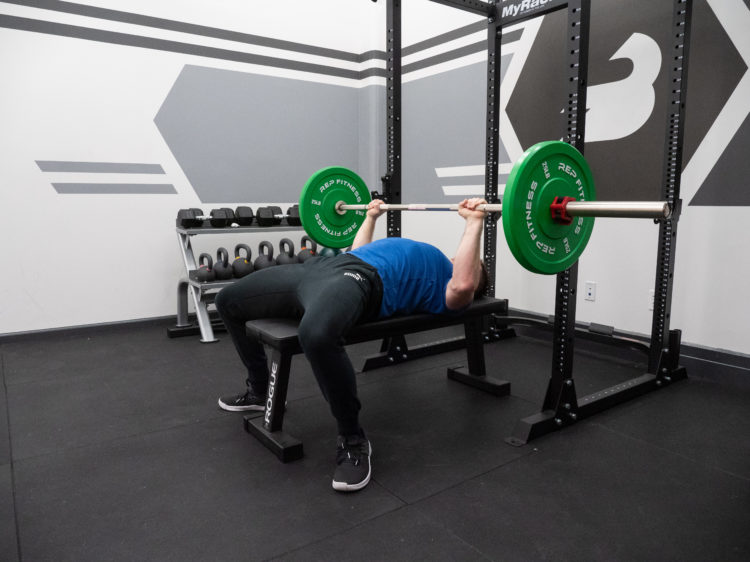Have you ever looked at your fellow gym goer and noticed them benching only to see their legs flailing around during the eccentric and concentric movement patterns? This is what we’d call having happy feet and it’s a great way to lose positioning and power production during the bench press.
This lack of stable positioning is where developing strong points of contact come into play. Point of contact are places on the body that make direct contact with the bench and barbell — and for the general fitness enthusiast that bench presses on a regular basis — there should be constant effort to maintain and improve these points.
Points of contact improve stability and positioning for the body during the bench, which is crucial for success. Strength can be displaced better from a stable base, so if the upper back, butt, or legs are actively moving during a bench press, then you’re leaving strength and power production on the table. In this article, we’ll talk about five points of contact that the recreational lifter should actively work to improve upon.

Author’s Note: This article is intended for recreational lifters, and not competitive powerlifters. If you compete, then your form and points of contact will be slightly different due to optimizing leverages, so these general guidelines may be limiting for your potential and sport!
What Are Points of Contact?
Points of contact are defined as areas on the body that are making direct contact with the bench and barbell. Basically, it’s the body parts making direct contact with the equipment being used for the exercise.
For recreational athletes, there are five points of contact that are useful to keep in mind when bench pressing. These points of contact include:
- The feet on the ground.
- Butt on the bench.
- Upper back on the bench.
- Head on the bench.
- Hands on the barbell.
5 Points of Contact On the Bench Press
1. Feet to the Ground
Useful Cues: Grip the floor and screw the feet in the floor.
The feet are paramount for a strong press because they contribute to leg drive, which is a major factor for power production off the chest. For the recreational lifter, feet that are flat will generally be the best bet to ensure they maintain this point of contact without any issue.
If the feet are too far out or too far inwards, then you’ll be more likely to experience them losing contact with the ground. A 70-90 degree angle of flexion at the knee with some variance will allow most lifters to maintain a strong position with the feet and ground.
2. Butt On the Bench
Useful Cues: Contract the glutes and lightly press them into the bench.
The glutes should maintain contact with the bench throughout the whole movement. Contract the glutes when eccentrically loading, then maintain that contraction through the concentric (pressing portion). If the hips are shooting up off then bench, then that’s a tell tale sign that the glutes and hips are not contracted and anchored.
For loose hips that are shooting upwards, focus on the feet and how you’re anchoring them, then bring your attention to your glute contraction. Try different angles with the feet and see if one promotes better positioning. Angle them out, bring them in and grip the floor, etc., and compare which feels best.
3. Upper Back On the Bench
Useful Cues: Put the scaps into the back pockets.
The upper back is possibly the most important point of contact within this list to nail every rep. If the back is “flat” on the bench, void of tension, then you’re losing the ability to translate eccentric load to concentric power. So by creating a strong shelf-like posture with the upper back, you’ll be much more in-tuned with utilizing the stretch-shortening cycle of the upper body.
Throughout the bench press, the upper back should remain tight and packed. If you’re reaching and protracting at the top of the movement, then you’ll be losing this valuable base of contact. If this is the case during your bench, try to shift the mindset from reaching with the weight to pressing and locking out.

4. Head On the Bench
Useful Cues: Maintain light contact on the bench.
For competitive powerlifters, the head is permitted to come off the bench, but for recreational lifters it’s usually a good idea to maintain its contact with the bench. If the head is coming up during the eccentric and it feels natural, then proceed, however, if it happens only at a certain intensity, then it might be worth exploring the “why” behind it.
5. Hands On the Bar
Useful Cues: Bend the bar and let the bar sit in the meat of the hands.
For recreational lifters (and competitive powerlifters for that matter), the hands should be making full contact with the barbell, a.k.a the thumbs will be wrapped. This, in general, will be a safer bet than going thumbless and using a suicide grip, which should be a pressing skill reserved for advanced athletes who have plenty of experience under the bar.
The goal should be optimizing surface area with the hands when working on this point of contact. In general, the cues bending the bar and letting the bar sit in the meat of the hands will be great starting points for ensuring you’re making the most of this point of contact.
Wrapping Up
Every exercise in the gym has points of contact and understanding how to properly use them is ideal for anyone trying to maximize their potential in a lift. For the bench press specifically, there are five main points of contact that the recreational lifter should be mindful of when trying to optimize their potential and sharpen their skills.
Think of points of contact as a chain. If one is off, then there’s a link that will indefinitely cause breakdown to some degree. A strong press starts from a stable base.